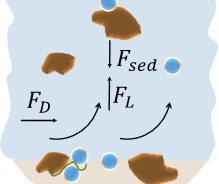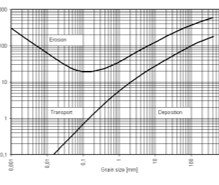Critical velocity for resuspension
The critical velocity for resuspension is the velocity at which the power of the moving water in a stream is sufficient to entrain a particle of a specific size. An empirically based method can be used to determine this velocity for a particular size particle. Often a set of size classes is used to describe a sediment in a water body, in which case the particle size used is the median of the particular class size. Critical current velocity for resuspension can be calculated based on the parameters of the medium used for the experimental setup and physical characteristics of the particles.
|
\(u_{cr}\) - critical current velocity (m/s) \(g\) - gravitational acceleration (m/s2) \(d\) - grain size median (m) \(v\) - water kinamatic viscosity (m2/s) \(c\) - coefficient for the critical velocity depending on the level of consolidation
|
The critical velocity (\(u_{cr}\)) for resuspension shows the minimum velocity needed to transport and erode a particle. |
Used for

Algorithm

Read more |
|
Consult the NanoFASE Library to see abstracts of these deliverable reports: |
Contact
 Frank von der Kammer
Frank von der Kammer
University of Vienna, Austria
Email: frank.von.der.kammer@univie.ac.at
